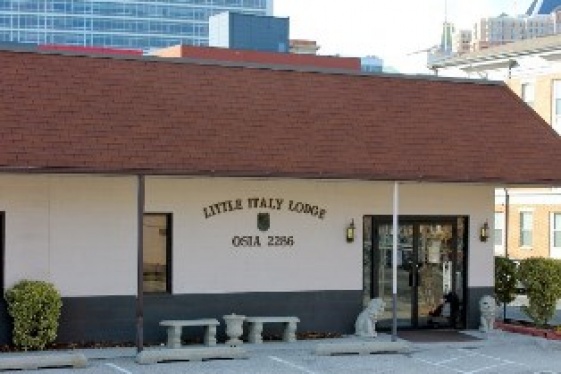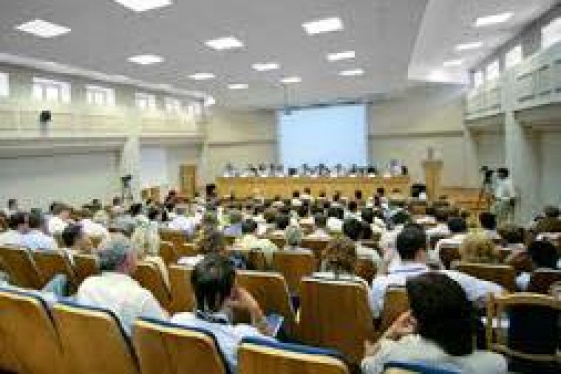
Michela Giorcelli (Author of the paper “Reconstruction Aid, Public Infrastructure, and Economic Development: The Case of the Marshall Plan in Italy”)
Andrà tutto bene. L'Italia ha già superato momenti terribili, peggiori di questi. Ma non dimentichiamoci mai di ringraziare gli Stati Uniti per il Piano Marshall

In these dangerous and tiring days, when the two countries we all love are the most affected in the world by this horrendous virus, many of us look with concern at what will happen when the health emergency will be over, or at least mitigated. It will be a very difficult time, our economies are and will be hard hit. Many people have compared the period ahead of us with the post-war period.
To give a message of hope, We the Italians thought to tell how Italy has come out of the Second World War: we have already overcome a terrible period, we will do it again. But we can never forget that in order to recover, then, we were helped by our American friends, who with the Marshall Plan gave decisive help to the whole of Western Europe.
We would like to thank Professor Michela Giorcelli, one of the Italians born here whose talent has also been recognized by the United States: she teaches economics at the Department of Economics of the University of California, and one of the topics she is an expert on is the Marshall Plan. It will not be easy but we will succeed, the relationship between Italy and the United States will become even stronger, and everything will be fine (andrà tutto bene).
Professor Giorcelli, you published a dissertation entitled “Economic Recovery and the Determinants of Productivity and Innovation: Evidence from Post-World War II Italy”. Also, together with Prof. Nicola Bianchi, an assistant professor in the Strategy Department at Kellogg School of Management and a faculty research fellow at the National Bureau of Economic Research, you have a paper entitled “Reconstruction Aid, Public Infrastructure, and Economic Development: The Case of the Marshall Plan in Italy”. Why did you choose this specific topic for your research?
I chose this topic for my research for two reasons: one is to better understand the Italian economic development during the 50s and the 60s and the other one is to answer a more general economic question.
On the first point, after World War II Italy experienced the so-called economic miracle with GDP growth of 6 percent per year. Historians have long associated this growth with the aid that Italy received through the Marshall Plan. Our research aims at quantifying the role that the Marshall plan played in Italian economic development after World War II.
On the second point, the Marshall Plan and the Italian case can be seen as a unique opportunity to study the effect of foreign aid on economic development. Today, foreign aid is one of the most popular form of aid for developing countries, but assessing its effectiveness is challenging mostly due to lack of long-term data. So, in this case evidence from economic history will help us to understand what the long-term effects of economic aid on a country’s development and growth are. Moreover, the Marshall Plan grouped together different types of aid, allowing us to study the impact of different types of aid on economic development.
In both your papers you address the fundamental role of the Marshall Plan on Italian Post World War II recovery. First of all, what was the Marshall Plan and why Italy was involved in it?
The Marshall Plan was an economic and financial program sponsored by the United States between 1948 and 1952 with the goal of helping western and southern Europe recover from World War II. Still today it is considered the largest foreign aid program ever experienced in the world; it accounted 5% of the American GDP in 1948 (which in terms of Italian GDP is roughly 2.5% of each year between 1948 and 1952).
The United States invited European countries to participate into the program: the participation was on a voluntary basis, so it was ultimately a decision of each country. To give an example, the plan was also offered to Eastern Europe that however refused it. Beyond its economic aspect, the Marshall Plan also had a strong political motivation. The American idea was to use economic aid to prevent the spread of the Communism that was a serious threat: the years 1946 and 1947 counted many strikes organized by the Communist party throughout all Western Europe. The United States helped European countries to have them on their side at the dawn of the Cold War.
In fact, while the Marshall Plan was specifically directed to Europe, there were also other programs for Asian countries such as Japan, to prevent Chinese expansion in that area.
Your first dissertation we mentioned is about, and I use your own words, “the economic development of Italy that, between the late 1940s and the early 1970s, moved from being a war-ravaged agricultural country to the seventh most industrialized power of the world.” How exactly the Marshall Plan helped Italy?
The Marshall Plan provided different types of aid to Italy. In the early 1948, it mostly transferred in-kind subsidies like food, medications and raw materials because of the World War II shortage. The majority of aid that Italy received between the end of 1948 and 1952 was composed of “reconstruction grants”, given to the Italian government to rebuild infrastructures that were damaged during World War II. In these five years a small part of money transfer was in form of loans to large Italian firms.
Starting 1952, the United States sponsored an additional program called “technical assistance and productivity program”. While the Marshall Plan until then had focused on rebuilding and increasing Italian production, in this second phase it aimed at increasing the productivity of Italian firms. To do so, the United States organized managerial training trips for Europeans managers at American firms and also granted loans to small and medium sized Italian firms in order to buy machineries produced in the United States.
Can you tell us more about this aid to productivity and technology?
The transfer of managerial knowledge had a large and persistent effect on firms performance: firms whose managers participated in the training trips in the United States were more likely to survive, and had higher sales, employment, and productivity that not participating companies. Those effects persisted for at least 15 years after the program. By contrast, firms that purchased new machineries from the United States improved their performances but only in the short run. The effects were smaller in magnitude and did not persist over the time, as in the case of the firms which did the managerial training trip.
With this respect, we can say that the Marshall Plan contributed to the provision of a managerial capital that, back then, most of European countries were lacking: and the lack of managerial capital is still a problem today in most countries, even in the developed world.
For instance, since the middle 1990s productivity growth in Southern Europe has been substantially lower than in other developed countries. Research conducted by Professors Schivardi and Schmitz argues that this lower productivity growth has been partially caused by inefficient manager practices which limited Southern Europe’s gains from the IT Revolution. A similar point is also made by Professors Pellegrino and Zingales with specific reference to Italy. Professors Bloom, Sadun and Van Reneen explain that the increasing of productivity gap between Europe and United States starting in 1995 is due to the adoption of information technologies by American multinationals, which are “better” managed. So, still today there are active research and debates about the role that managerial capital has on the industrial activity and more in general on firm’s performance. The Marshall Plan was pioneering this type of transfer from more developed to less developed countries.
Did the Marshall Plan help all Italian provinces in the same way?
The Marshall Plan aid was allocated largely based on the Italian provinces need of infrastructure’s reconstruction after World War II. Infrastructure’s damages were, in turn, strongly related to the exposure to the war and bombing, especially after the armistice in 1943. The armistice marked a change in the type of bombing that Italy was exposed to, in the sense that the Allies started bombing infrastructures and specifically roads, rail roads and bridges with the goal of preventing German troupes stuck in Italy to go back to Germany. So, as a result, war damages and aid were concentrated more north of the Gothic line (the last major line of defence along the summits of the northern part of the Apennine Mountains in the Italian region Emilia Romagna) where the conflict lasted longer.
However, in the same region, different provinces were exposed differently to bombing episodes and, therefore, they received different amount of Marshall Plan grants after World War II.
How can we summarize the conclusions that you and Professor Bianchi came to about the benefit that Italy got from the American Marshall Plan money
The Marshall Plan had positive effects on Italian provinces’ economic development as it is demonstrated by our study, which shows that provinces which received more reconstruction grants through the Marshall Plan not only rebuilt their infrastructure network, but were also able to redesign and modernize it. This modernization affected the provinces’ agricultural and industrial outcomes. Provinces that received more aid increased their agricultural production between 10 and 20% for all major crops, and we think that more efficient infrastructure network allowed farms to sell their products on a larger market.
Moreover, we also observe an increase in the technology adopted in the agricultural sector: specifically there was a strong increase in the number of tractors and this is strongly related to the Marshall Plan, because these type of machines had been widely used in the US agricultural sector right before World War II.
Finally, we document structural changes in the labour market: employment in the agricultural sector dropped by more than 20% and these workers were absorbed by the industrial and service sectors. Moreover, in the industrial sector there was an increase in the number of firms, especially small-sized ones (i.e., firms with less than 10 employees): we think that the more efficient infrastructure network attracted new firms which decided to locate close to it.
So, we can conclude that the Marshall Plan had a positive direct effect on the Italian post World War II economic miracle. In fact, two of our main findings - the technology adoption in agricultural sector and the shift of employment from the agricultural to the industrial and service sector - were the two main characteristics of the Italian post World War II economic development phase.
However, the Marshall Plan did not reduce the pre-existing regional inequalities: southern provinces which were less developed than northern ones were less exposed to bombing after 1943, therefore received less aid from the Marshall Plan.
Professor, you live in Los Angeles, where you teach economics at the University of California. When the nightmare of the coronavirus ends, Italy will find itself in a situation that, according to many people, already has some similarities with the one it was in after the Second World War. But there can be no new Marshall Plan from America. What do you think Italy has to do to get up and grow again? Are we going to make it?
For sure, Italy is facing an extremely hard moment and the number of countries which are involved in the current crisis, including the US themselves, may recall a world war. However, I think that there are important differences between these two events.
First of all, the general widespread destruction that was there after World War II is not going to be there this time: Italy will still have its production capacity, its infrastructure’s network, and will be able to rely on a much more specialized labour-force than after World War II. In this respect, I think that even without any foreign aid, the recovery from this crisis will be easier and faster than it was after World War II.
However, I think that in this situation, management could and should play an important role in pushing the country recover. In my view, this crisis may represent an opportunity to modernize managerial structure, reorganize production in order to adapt faster to a changing world (and part of this change will be driven by the crisis itself), and finish the still uncomplete IT revolution in all the sectors of the economy: health, education, industry, services. For sure, if these changes are made, they will give us huge productivity gains in the future and this will definitely help Italy recover and start growing again. And, as it always happens in Italian history, I’m sure that even this time we will make it! Italians are fantastic, especially in hard times!
How do you see the future of the relationship between Italy and the United States after the end of this crisis?
I expect the relationship between Italy and the United States to become stronger than ever after this crisis. Since the aftermath of World War II, Italy and United States have built a strong economic relationship. The United States have been one of our major trading partners, especially for the “made in Italy” exports.
But there is much more than that. Italy and the United States have promoted an intense scientific and cultural collaboration, ranging from academic research and climate change challenges to student exchange, art, tourism, and food. Old migration at the beginning of the 20th century has melted with the current one. This relationship will not be harmed by the current crisis. Conversely, after its end, the restart of these exchanges will be crucially important to help economic recovery, with mutual benefits for both countries.
You may be interested
-
“The Art of Bulgari: La Dolce Vita & Beyond,...
by Matthew Breen Fashion fans will be in for a treat this fall when the Fine Arts Museums...
-
13th Annual Galbani Italian Feast of San Gen...
In September of 2002, some of Los Angeles' most prominent Italian American citizens got to...
-
1st Annual Little Italy Cannoli Tournament
Little Italy San Jose will be hosting a single elimination Cannoli tournament to coincide...
-
2015 scholarship competition
The La Famiglia Scholarship committee is pleased to announce the financial aid competition...
-
Candice Guardino Brings GILDA AND MARGARETTE...
Candice Guardino is adding to her list of successful theatrical productions with the debut...
-
Emanuele: cervello d'Italia al Mit di Boston
Si chiama Emanuele Ceccarelli lo studente del liceo Galvani di Bologna unico italiano amme...
-
Festa Coloniale Italiana 2012
We are very excited to announce that on Saturday, August 11, The San Francisco Italian Ath...
-
ISSNAF medical imaging science chapter meeti...
AGENDA 12.00 – 12.15 Light lunch12.15 – 12.30Welcome addresses Lorenzo Mannelli, MD, PhD...





















